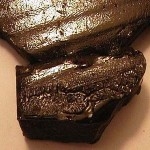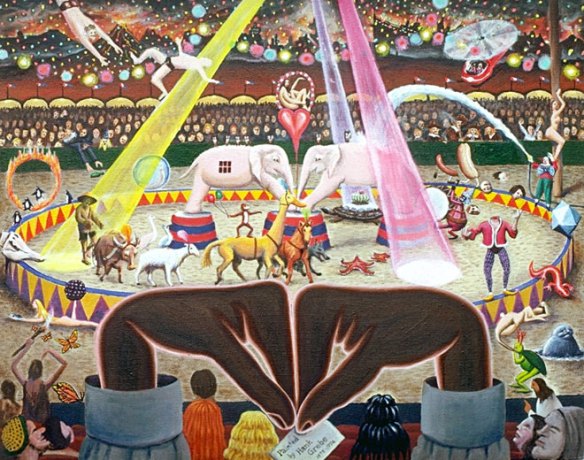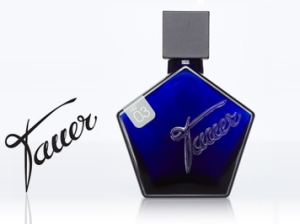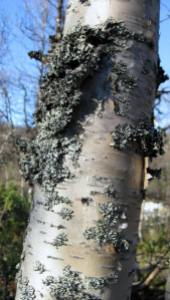In March 2013, Tom Ford released a new fragrance in his Signature collection called Sahara Noir. It is a rich oriental eau de parfum that is aimed at the Middle Eastern market and that is supposedly Tom Ford’s interpretation of their traditional scents. On May 1, Sahara Noir became available world-wide, and I obtained a sample from a kind sales-assistant at Neiman Marcus. The long and short of it is that Sahara Noir is, essentially, a re-working of Tom Ford’s much beloved, now discontinued Private Blend Amber Absolute, only with oud now added to the mix. There are small differences which I’ll explain later in this review but, for all intents and purposes, Sahara Noir is the new replacement for Amber Absolute.
In the press release I found back in February, Sahara Noir is described as follows:
Sahara Noir is rich and exotic; it wraps the balsamic, incense-touched notes of frankincense in gold and honey-coloured light,” noted Ford. “Middle Eastern culture has an extraordinary appreciation for the luxurious, emotional and memorable qualities of fragrance; perfume is worn there in a way that feels very familiar to me. Sahara Noir is my interpretation of this heritage.
 The press release is actually important because of its detailed explanation of the notes — notes which are quite different from what Fragrantica lists. In the official description of the perfume, the company states:
The press release is actually important because of its detailed explanation of the notes — notes which are quite different from what Fragrantica lists. In the official description of the perfume, the company states:
The oriental woody juice is crafted around a heart of frankincense. This key ingredient is complemented by top notes of cistus essence Orpur® (Orpur denotes a natural ingredient of exceptional quality and purity), bitter orange, Jordanian calamus – an oasis sweet grass – and Levantine cypress, famed for growing in the gardens of the 1001 Arabian Nights.
The heart blends frankincense essence Orpur® , cinnamon, cool papyrus extract, Egyptian jasmine templar and rose absolute from Morocco. A beeswax extraction from Burma lends body and a supple, honeyed-animalic richness.
The warm dry down is laced with amber. It is formed by a special blend of labdanum – labdanum absolute and a rich natural fraction of labdanum known as ambreinol – combined with benzoin, vanilla, cedar, frankincense resin, agarwood and balsam.
The notes on Fragrantica mention only:
Top notes are bergamot, mandarin orange, violet, ginger and basil; middle notes are grapefruit blossom, orange blossom, tobacco and black pepper; base notes are amber, cedar, patchouli, oakmoss and leather.
So, if we combine the two lists together, the full set of notes seems to be closer to the following:
bergamot, mandarin orange, violet, ginger, basil, grapefruit blossom, orange blossom, tobacco, black pepper, amber, cedar, patchouli, oakmoss, leather, Jordanian calamus grass, cistus [labdanum] essence Orpur®, cinnamon, papyrus extract, Egyptian jasmine templar, Moroccan rose absolute, beeswax extract, labdanum, ambreinol, benzoin, vanilla, frankincense resin, agarwood [oud], and balsam.
A slightly different set of notes, all in all, don’t you think?
Sahara Noir opens on my skin as slightly bitter amber with heavy frankincense. There are: bitter citruses that feel like the fresh oils from the rind; peppery cedarwood; dry tobacco leaves; bitter but crystalized ginger; and black, dirty patchouli. The whole thing sits atop a powerful base of rich, nutty, heavily leathered labdanum (a type of amber resin), infused with strong frankincense. The amber-frankincense duet smells familiar — as it should to anyone who has smelled Amber Absolute. As the seconds pass, light touches of cinnamon and rich, heavy honey are also noticeable. The whole thing is potent and, yet, much airier and lighter than you’d suspect, given those rich, heavy notes. I’m not saying that Sahara Noir is a sheer, translucent, fresh scent by any means, but it doesn’t feel opaque, thick, and molten.
Less than five minutes into Sahara Noir’s development, the perfume shifts a little and becomes significantly less complex. The citrus notes have all but vanished, leaving behind a scent that is primarily frankincense-infused labdanum amber. Those who don’t like labdanum as a stand-in for amber should perhaps take heed, for Rock Rose or Cistus (its other names) is not to everyone’s taste. Labdanum has quite a masculine, leathery bent to its nutty, resinous, darkly balsamic accord, and I know some amber lovers who aren’t always enthused by its particular aroma.
Swirled into the blend are tobacco leaves, peppery cedar wood, dry papyrus, and the smallest suggestion of oud. The perfume is beautifully blended, so few of these notes are individually distinctive by themselves amidst that dominant pairing of frankincense and labdanum. Yet, by the end of the first hour, the peppery wood notes and oud become much more significant. The tobacco fades away, along with the faint traces of spice and ginger that lurked in the opening. By the 90 minute mark, Sahara Noir is a three-way pairing of labdanum, frankincense and oud. As a side note about that oud, I know a lot of my regular readers really struggle with the note. I do, too, when it is medicinal, antiseptic, fecal, or a bit too much of the noble “rot.” Here, however, it is much more akin to incredibly peppered woods. It’s simultaneously dry, a little bit fiery, and highly sweetened (thanks to the resins and honey)– all at the same time. Yet, for the most part, it is not over-powering or bullying; it is far too overshadowed by the leathery amber and frankincense.
Sahara Noir remains as this triumvirate for hours and hours. I detect absolutely no citrus or floral notes; not a whisper of rose or jasmine anywhere in sight. Midway during the third hour, the perfume becomes richer and softer, turning into a lovely amber with strong oud and frankincense. The labdanum’s leathery edges have been tamed, mellowing into something sweeter and milder with a honeyed accord. The frankincense is in much better balance, though the oud seems to have increased a little in strength. I will be honest and confess that the oud is a little too much for my personal tastes and a little sharp at times, but it is in perfectly equal proportion to the other two notes. Sahara Noir is now a three-way race, with each horse neck-and-neck as they lead into the home-stretch.
With every remaining hour, the triplets soften even further until, finally, Sahara Noir turned into a nutty, honeyed amber with faint traces of smoke and oud. Lurking at the edges is the merest dash of cinnamon, benzoin and vanilla — the latter having a breath of powder — but neither note is very significant. In the final hours, and to my surprise, I could occasionally detect some vague, soft floral notes underlying the amber. It felt most like jasmine, but the whole thing was a bit too muted and amorphous to really tell. Plus, every time I thought I could pinpoint it on my arm, the note flitted away like a ghost. By the very end, Sahara Noir was nothing more than a faint whisper of nutty amber with a soft feel of caramel.
All in all, Sahara Noir lasted just over 9 hours on my perfume-consuming skin. As always with Tom Ford fragrances, I opt for a lesser amount than what I would normally use with everything else. It was Amber Absolute, actually, which taught me it is best to err on the side of caution initially when it comes to the quantity one uses for one of his perfumes. Using the equivalent of two good sprays on my arm, Sahara Noir was generally quite light in feel. It had serious sillage at first which dropped to “average” after the first hour. At that point, someone standing a few feet away wouldn’t be able to detect it, but don’t let that mislead you. When sniffing it, Sahara Noir is very potent, thanks to the frankincense. If you were to spray more than a small amount, I suspect the sillage might blow someone out of the water. I also think a larger quantity would change the nature of the perfume. Time and time again with Tom Ford’s Private Blend fragrances, I’ve noticed that using too much can lead to quite an overwhelming, ’80s-like experience and, more importantly, to the amplification of whatever note is dominant in the perfume. In this case, the frankincense.
As I noted at the start, Sahara Noir is extremely close to Tom Ford’s Amber Absolute from his much more expensive, more “prestige” Private Blend collection. Amber Absolute was discontinued last year for reasons that I’ve never quite fathomed. It seemed to be one of the big favorites amongst the Tom Ford line as a whole — cherished and adored by a vast number of people, especially friends of mine who enjoy rich amber scents with smoke. I reviewed Amber Absolute and, personally, found the extreme nature of the frankincense to be a bit bullying — and that’s coming from someone who really enjoys the note. For me, the perfume was unbalanced, too shrill and top-heavy with the frankincense, and just a bit too, too much as a whole. I always thought I was in the minority on that assessment, but Sahara Noir makes me wonder if, perhaps, there were more people who shared my views.
You see, Sahara Noir is a much less extreme, more balanced version of Amber Absolute. There is still the labdanum-frankincense accord, but the smoke doesn’t feel acrid and like an 800-pound gorilla. To my nose, Sahara Noir is also slightly more nuanced, along with having a lighter feel and texture, but it’s definitely all relative. There are other — albeit small — differences as well. For one thing, the opening to the two fragrances is not quite the same: the Amber Absolute has much more of a boozy rum, spiced start; Sahara Noir is more citrus-y (for all of about 5 minutes), before turning straight to the labdanum and frankincense. It also has far more dry wood notes, from the very peppery cedar to the oud. Of course, the inclusion of that last element is quite a big difference, though I would argue that — for the most part — it’s a difference of degree and not of kind. The dominance of the core labdanum-frankincense combination in both fragrances makes them much more alike than different, despite the addition of the oud.
All in all, I liked Sahara Noir — but I didn’t love it and I don’t think I’d wear it. For one thing, I’m extremely tired of oud — there seems to be no end in sight to the mania. Everything has oud in it these days. (At this rate, it’s going to be on my bloody pizza next!) Perhaps if I didn’t test at least one oud fragrance a week (and, sometimes, as many three), I’d be more enthusiastic. But Sahara Noir isn’t complex enough to sway my oud fatigue.
For another, while I like frankincense a great deal, I find there is always something a little sharp in the frankincense use by Tom Ford. Sahara Noir lacks the soft, luxuriating, velvety richness of Dior‘s Mitzah, one of my favorite labdanum-frankincense combinations and a fragrance which I thought was much more complex, nuanced, and layered. Perhaps it’s because Mitzah isn’t so focused on just two key notes, and its edges are softened as a result. In particular, both the labdanum and the frankincense in Mitzah are gentler, more rounded, better blended and richer. Perhaps it’s because Mitzah lacks oud with its peppery element which is sometimes a little sharp in Sahara Noir. Whatever the reason, I liked Sahara Noir — but not enough to want to wear it.
As a side note, I cannot help but think Tom Ford decided to tone down his Amber Absolute, while also adding in oud, for marketing reasons. With the inclusion of that note, he could target the extremely wealthy Middle Eastern market, and position Sahara Noir as an exciting new call to their traditional heritage of oud fragrances, as well as heavy, balsamic amber ones. What stumps me is why Sahara Noir isn’t part of his more expensive, potent Private Blend line, instead of the cheaper Signature collection. His intended audience could certainly afford it. I suspect it’s because he didn’t want to underscore quite so easily the enormous overlap between Sahara Noir and a Private Blend fragrance that he just discontinued.
Another source of bewilderment: Sahara Noir is supposedly marketed as a fragrance “for women.” Er…no. I don’t think so! Sahara Noir is as unisex as you can get. In fact, I suspect women who are not used to oud (or heavy frankincense) may blink a little at Sahara Noir. This is not some sweet, gourmand, or spiced soft amber. This is hardcore frankincense and labdanum.
On Fragrantica, the comments thus far seem generally to evince disappointment, though quite a few people really enjoy it. A number of people write about how it is primarily a frankincense fragrance and nothing revolutionary. Well, they’d be right, especially as Sahara Noir replicates Amber Absolute so closely. Two commentators seem to feel it is a complete “knock-off” of Absolue Pour Le Soir by Maison Francis Kurkdjian. With that, I very much disagree. I’ve reviewed Absolue Pour Le Soir and think it is absolutely nothing like Sahara Noir. Absolue is not an ode to frankincense and labdanum; it is a stunning floral oriental that is centered around slightly animalic musk with lovely, rich sandalwood and a variety of other elements.
Some have called Sahara Noir “linear,” and I think it is. But I’ve always thought that term is a negative only when someone absolutely hates the notes that are continuing from start to finish. If you love a rich amber infused with the particularly intense sort of smoke that is frankincense, and if you like the slightly masculine, leathery sort of amber that is labdanum, then I think you might enjoy Sahara Noir. However, those who don’t like oud may not be enthusiastic, and those who already own Amber Absolute can probably skip it.





















